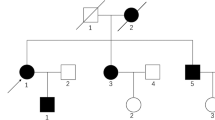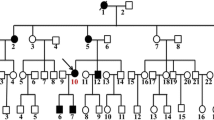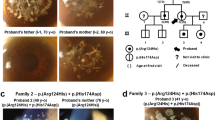Abstract
Purpose
To evaluate the correlation between surgical outcome after phototherapeutic keratectomy in patients with autosomal dominant transforming growth factor, beta-induced (TGFBI)-linked corneal dystrophies (CD) and molecular genetic findings regarding the TGFBI gene.
Methods
Twelve patients were examined to investigate genotype by direct sequencing of the TGFBI gene. Twenty eyes of 12 patients were treated with phototherapeutic keratektomy (PTK) to remove superficial corneal opacifications and to decrease recurrent erosions. Surgical outcome, including visual improvement, recurrence of opacifications, postoperative complications, and additional therapeutic proceedings were reported and compared with the molecular genetic results.
Results
Four different missense mutations were identified within the coding region of the TGFBI gene: Arg124Cys in one eye, Arg555Trp in nine eyes, Arg124His in four eyes and Gly623Arg in six eyes. In all eyes the PTK was successful without clinically significant recurrent opacifications after a mean follow-up time of 17.6 months (min 3 months, max 42 months). The best corrected visual acuity (BCVA) improved with an average increase of 3.1 lines (minimum 2 lines, maximum 5 lines). In one eye (Arg124Cys), we observed delayed wound healing and a delayed increase in BCVA, in two eyes we performed an Epilasik to correct remaining hyperopia, and in four eyes we fitted rigid gas-permeable tricurve contact lenses to correct the remaining irregular astigmatism.
Conclusions
The variable genotypes in patients with TGFBI-linked corneal dystrophies lead to significantly different results after surgical treatment. The Gly623Arg mutation seems to be an optimum genotype on which to perform PTK even in older patients. It is essential to determine the genotype in order to standardize the PTK treatment and to evaluate the success in TGFBI-linked corneal dystrophies.


Similar content being viewed by others
References
Munier FL, Frueh BE, Othenin-Girard P, Uffer S, Cousin P, Wang MX et al (2002) BIGH3 mutation spectrum in corneal dystrophies. Invest Ophthalmol Vis Sci 43:949–954
Ellies P, Renard G, Valleix S, Boelle PY, Dighiero P (2002) Clinical outcome of eight BIGH3-linked corneal dystrophies. Ophthalmology 109:793–797 doi:10.1016/S0161 6420(01)01025-9
Mashima Y, Yamamoto S, Inoue Y, Yamada M, Konishi M, Watanabe H et al (2000) Association of autosomal dominantly inherited corneal dystrophies with BIGH3 gene mutations in Japan. Am J Ophthalmol 130:516–517 doi:10.1016/S0002-9394(00)00571-7
Fujiki K, Hotta Y, Nakayasu K, Yamaguchi T, Kato T, Uesugi Y et al (2000) Six different mutations of TGFBI (betaig-h3, keratoepithelin) gene found in Japanese corneal dystrophies. Cornea 19:842–845 doi:10.1097/00003226-200011000-00015
Korvatska E, Munier FL, Djemai A, Wang MX, Frueh B, Chiou AG et al (1998) Mutation hot spots in 5q31-linked corneal dystrophies. Am J Hum Genet 62:320–324 doi:10.1086/301720
Stone EM, Mathers WD, Rosenwasser GO, Holland EJ, Folberg R, Krachmer JH et al (1994) Three autosomal dominant corneal dystrophies map to chromosome 5q. Nat Genet 6:47–51 doi:10.1038/ng0194-47
Munier FL, Korvatska E, Djemai A, Le Paslier D, Zografos L, Pescia G et al (1997) Kerato-epithelin mutations in four 5q31-linked corneal dystrophies. Nat Genet 15:247–251 doi:10.1038/ng0397-247
Korvatska E, Munier FL, Chaubert P, Wang MX, Mashima Y, Yamada M et al (1999) On the role of kerato-epithelin in the pathogenesis of 5q31-linked corneal dystrophies. Invest Ophthalmol Vis Sci 40:2213–2219
Klintworth GK, Valnickova Z, Enghild JJ (1998) Accumulation of beta ig-h3 gene product in corneas with granular dystrophy. Am J Pathol 152:743–748
Streeten BW, Qi Y, Klintworth GK, Eagle RC Jr, Strauss JA, Bennett K (1999) Immunolocalization of beta ig-h3 protein in 5q31-linked corneal dystrophies and normal corneas. Arch Ophthalmol 117:67–75
Dighiero P, Niel F, Ellies P, D’Hermies F, Savoldelli M, Renard G et al (2001) Histologic phenotype-genotype correlation of corneal dystrophies associated with eight distinct mutations in the TGFBI gene. Ophthalmology 108:818–823 doi:10.1016/S0161-6420(00)00662-X
El-Ashry MF, El-Aziz MM, Larkin DF, Clarke B, Cree IA, Hardcastle AJ et al (2003) A clinical, histopathological, and genetic study of Avellino corneal dystrophy in British families. Br J Ophthalmol 87:839–842 doi:10.1136/bjo.87.7.839
El-Ashry MF, El-Aziz MM, Hardcastle AJ, Bhattacharya SS, Ebenezer ND (2005) A clinical and molecular genetic study of autosomal-dominant stromal corneal dystrophy in British population. Ophthalmic Res 37:310–317 doi:10.1159/000087791
Fujiki K, Nakayasu K, Kanai A (2001) Corneal dystrophies in Japan. J Hum Genet 46:431–435 doi:10.1007/s100380170041
Gupta SK, Hodge WG, Damji KF, Guernsey DL, Neumann PE (1998) Lattice corneal dystrophy type 1 in a Canadian kindred is associated with the Arg124->Cys mutation in the kerato-epithelin gene. Am J Ophthalmol 125:547–549 doi:10.1016/S0002-9394(99)80196-2
Grünauer-Kloevekorn C, Bräutigam S, Wolter-Roessler M, Tost F, Weidle E, Froster U et al (2005) Molekulargenetische Analyse des BIGH3-Gens bei gittriger Hornhautdystrophie Typ I (Biber-Haab-Dimmer) und bei bröckliger Hornhautdystrophie Typ II (Avellino): Erlauben Hot Spots einen indirekten Mutationsnachweis? Klin Monatsbl Augenheilkd 222:1017–1023 doi:10.1055/s-2005-858589
Klintworth GK, Bao W, Afshari NA (2004) Two mutations in the TGFBI (BIGH3) gene associated with lattice corneal dystrophy in an extensively studied family. Invest Ophthalmol Vis Sci 45:1382–1388 doi:10.1167/iovs.03-1228
Korvatska E, Munier FL, Djemai A, Wang MX, Frueh B, Chiou AG et al (1998) Mutation hot spots in 5q31-linked corneal dystrophies. Am J Hum Genet 62:320–324 doi:10.1086/301720
Eifrig DE Jr, Afshari NA, Buchanan HW 4th, Bowling BL, Klintworth GK (2004) Polymorphic corneal amyloidosis: a disorder due to a novel mutation in the transforming growth factor beta-induced (BIGH3) gene. Ophthalmology 111:1108–1114 doi:10.1016/j.ophtha.2003.09.043
Endo S, Nguyen TH, Fujiki K, Hotta Y, Nakayasu K, Yamaguchi T et al (1999) Leu518Pro mutation of the beta ig-h3 gene causes lattice corneal dystrophy type I. Am J Ophthalmol 128:104–106 doi:10.1016/S0002-9394(99)00053-7
Fujiki K, Hotta Y, Nakayasu K, Yokoyama T, Takano T, Yamaguchi T et al (1998) A new L527R mutation of the betaIGH3 gene in patients with lattice corneal dystrophy with deep stromal opacities. Hum Genet 103:286–289 doi:10.1007/s004390050818
Hirano K, Hotta Y, Nakamura M, Fujiki K, Kanai A, Yamamoto N (2001) Late-onset form of lattice corneal dystrophy caused by leu527Arg mutation of the TGFBI gene. Cornea 20:525–529 doi:10.1097/00003226-200107000-00017
Stewart H, Black GC, Donnai D, Bonshek RE, McCarthy J, Morgan S et al (1999) A mutation within exon 14 of the TGFBI (BIGH3) gene on chromosome 5q31 causes an asymmetric, late-onset form of lattice corneal dystrophy. Ophthalmology 106:964–970 doi:10.1016/S0161-6420(99)00539-4
Chakravarthi SV, Kannabiran C, Sridhar MS, Vemuganti GK (2005) TGFBI gene mutations causing lattice and granular corneal dystrophies in Indian patients. Invest Ophthalmol Vis Sci 46:121–125 doi:10.1167/iovs.04-0440
Panda A, Bageshwar LM, Ray M, Singh JP, Kumar A (1999) Deep lamellar keratoplasty versus penetrating keratoplasty for corneal lesions. Cornea 18:172–175 doi:10.1097/00003226-199903000-00005
Cursiefen C, Kuchle M, Naumann GO (1998) Changing indications for penetrating keratoplasty: histopathology of 1,250 corneal buttons. Cornea 17:468–470
Hyman L, Wittpenn J, Yang C (1992) Indications and techniques of penetrating keratoplasties, 1985–1988. Cornea 11:573–576 doi:10.1097/00003226-199211000-00015
Lee ES, Kim EK (2003) Surgical do’s and don’ts of corneal dystrophies. Curr Opin Ophthalmol 14:186–191 doi:10.1097/00055735-200308000-00003
Hahn TW, Sah WJ, Kim JH (1993) Phototherapeutic keratectomy in nine eyes with superficial corneal diseases. Refract Corneal Surg 9(Suppl 2):S115–S118
Das S, Langenbucher A, Seitz B (2005) Excimer laser phototherapeutic keratectomy for granular and lattice corneal dystrophy: a comparative study. J Refract Surg 21:727–731
Rapuano CJ (2005) Excimer laser phototherapeutic keratectomy in eyes with anterior corneal dystrophies: short-term clinical outcomes with and without an antihyperopia treatment and poor effectiveness of ultrasound biomicroscopic evaluation. Cornea 24:20–31 doi:10.1097/01.ico.0000134184.47687.bb
Fagerholm P (2003) Phototherapeutic keratectomy: 12 years of experience. Acta Ophthalmol Scand 81:19–32 doi:10.1034/j.1600-0420.2003.00015.x
Dinh R, Rapuano CJ, Cohen EJ, Laibson PR (1999) Recurrence of corneal dystrophy after excimer laser phototherapeutic keratectomy. Ophthalmology 106:1490–1497 doi:10.1016/S0161-6420(99)90441-4
Nassaralla BA, Garbus J, McDonnell PJ (1996) Phototherapeutic keratectomy for granular and lattice corneal dystrophies at 1.5 to 4 years. J Refract Surg 12:795–800
Dogru M, Katakami C, Nishida T, Yamanaka A (2001) Alteration of the ocular surface with recurrence of granular/avellino corneal dystrophy after phototherapeutic keratectomy: report of five cases and literature review. Ophthalmology 108:810–817 doi:10.1016/S0161-6420(00)00657-6
Stewart OG, Pararajasegaram P, Cazabon J, Morrell AJ (2002) Visual and symptomatic outcome of excimer phototherapeutic keratectomy (PTK) for corneal dystrophies. Eye 16:126–131 doi:10.1038/sj/eye/6700049
Inoue T, Watanabe H, Yamamoto S, Inoue Y, Okada M, Hori Y et al (2001) Different recurrence patterns after phototherapeutic keratectomy in the corneal dystrophy resulting from homozygous and heterozygous R124H BIG-H3 mutation. Am J Ophthalmol 132:255–257 doi:10.1016/S0002-9394(01)00824-8
Inoue T, Watanabe H, Yamamoto S, Maeda N, Inoue Y, Shimomura Y et al (2002) Recurrence of corneal dystrophy resulting from an R124H Big-h3 mutation after phototherapeutic keratectomy. Cornea 21:570–573 doi:10.1097/00003226-200208000-00007
Amm M (1999) Phototherapeutische Keratektomie (PTK) - Eine erfolgreiche Therapiemethode bei Thiel-Behnke-Dystrophie und deren Rezidiven. Ophthalmologe 96:489–493 doi:10.1007/s003470050442
Das S, Langenbucher A, Seitz B (2005) Delayed healing of corneal epithelium after phototherapeutic keratectomy for lattice dystrophy. Cornea 24:283–287 doi:10.1097/01.ico.0000138853.26332.55
Kawamoto K, Morishige N, Yamada N, Chikama T, Nishida T (2006) Delayed corneal epithelial wound healing after penetrating keratoplasty in individuals with lattice corneal dystrophy. Am J Ophthalmol 142:173–174 doi:10.1016/j.ajo.2006.01.077
Foerster CG, Langenbucher A, Cursiefen C, Kruse FE, Seitz B (2007) Delayed epithelial healing after keratoplasty for lattice corneal dystrophy. Cornea 26:1182–1183
Nemeth G, Felszeghy S, Kenyeres A, Szentmary N, Berta A, Suveges I, Modis L (2008) Cell adhesion molecules in stromal corneal dystrophies. Histol Histopathol 23:945–952
Fountain TR, de la Cruz Z, Green WR, Stark WJ, Azar DT (1994) Reassambly of corneal epithelial adhesion structures after ecimer laser keratectomy in humans. Arch Ophthalmol 112:967–972
Alvardo J, Murphy C, Juster R (1983) Age-related changes in basement membrane of the human corneal epithelium. Invest Ophthalmol Vis Sci 24:1015–1028
Morand S, Buchillier V, Maurer F, Bonny C, Arsenijevic Y, Munier FL et al (2003) Induction of apoptosis in human corneal and HeLa cells by mutated BIGH3. Invest Ophthalmol Vis Sci 44:2973–2979 doi:10.1167/iovs.02-0661
Boutboul S, Black GC, Moore JE, Sinton J, Menasche M, Munier FL et al (2006) A subset of patients with epithelial basement membrane corneal dystrophy have mutations in TGFBI/BIGH3. Hum Mutat 27:553–557 doi:10.1002/humu.20331
Acknowledgments
This study was supported by the European Social Fund and the State of Sachsen-Anhalt, Germany. The authors would like to thank Mrs. Katherine Dege, Germany, for editing the manuscript.
Author information
Authors and Affiliations
Corresponding author
Rights and permissions
About this article
Cite this article
Gruenauer-Kloevekorn, C., Braeutigam, S., Froster, U.G. et al. Surgical outcome after phototherapeutic keratectomy in patients with TGFBI-linked corneal dystrophies in relation to molecular genetic findings. Graefes Arch Clin Exp Ophthalmol 247, 93–99 (2009). https://doi.org/10.1007/s00417-008-0931-3
Received:
Revised:
Accepted:
Published:
Issue Date:
DOI: https://doi.org/10.1007/s00417-008-0931-3




